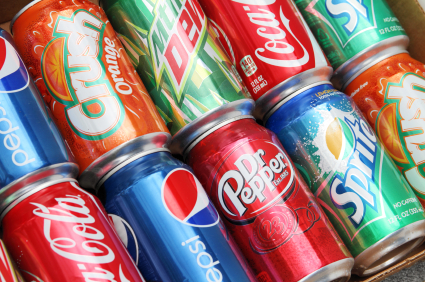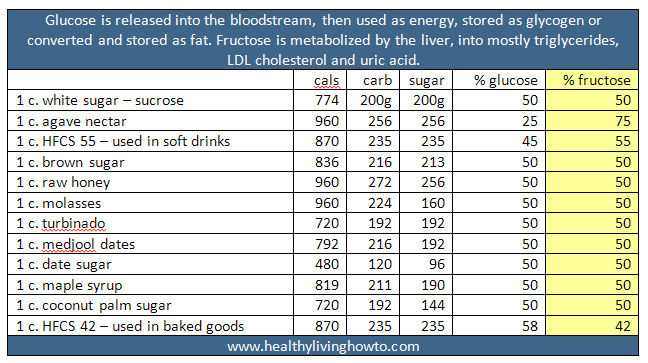According to a new study published in the journal Nutrition, the lion's share of calories, in American adult and adolescent diets, comes from — soda. Yes soda. Source

Let's take a closer look at Americans' beverage of choice.
An average 12 oz. can of soda has 150 empty calories. Empty, because all of those calories, derived from sugar, provide the body with no nutritional value and in fact actually deplete the body of vital nutrients. Just one can contains 39 grams of sugar, of which 70% or 22 g is fructose, the remaining is glucose.
Most sodas are sweetened with high-fructose corn syrup (HFCS) although there are some that are sweetened with cane sugar under the guise of being “healthier”. We'll get to that in a moment…
What so bad about fructose?
The science is overwhelmingly clear on this point: fructose and glucose are NOT metabolized by your body in the same way. For example, while every cell in your body utilizes glucose, thereby burning up much of it, fructose is turned into free fatty acids (FFAs), VLDL (the damaging form of cholesterol), and triglycerides, which get stored as fat. Furthermore, the entire burden of metabolizing fructose falls on your liver, which creates a long list of waste products and toxins, including a large amount of uric acid, which drives up blood pressure and causes gout. It also promotes visceral fat. As a standard recommendation, I advise keeping your total fructose consumption below 25 grams per day, or as little as 15 grams a day if you have insulin resistance, diabetes, high blood pressure, heart disease or are overweight. Source
Just one can of soda a day is about all you get when it comes to a healthy level of fructose consumption. However, according to the study referenced above, we are more than exceeding this recommended amount, not just in soda but in store-bought grain-based desserts as well.
Yes, coming in number two for adults and number one for children, is sugar-sweetened (more fructose) store-bought junk food. Source
I imagine, parents of small children recognize that soda is not healthy and refrain more often from giving it to their children, yet when it comes to cookies, cakes, muffins, donuts, pastries, etc. there is less of a stigma.
What's the difference between sugar and HFCS?
While most have heard of the evils of HFCS, when it comes to fructose content, it really isn't all that different from just about every other form of sugar on the market.
High-fructose corn syrup is labeled as such because it has more fructose than regular corn syrup and the percentage of fructose depends on what it is being used for, with the 55% being used for liquid applications and the 42% used in baked goods.
As you can see from the chart below, with the exception of agave nectar, the fructose content of the various forms of sugar are all about the same. Even the “natural” sweeteners with health halos like honey, maple syrup and coconut palm sugar are half fructose. This explains what I referenced earlier, when it comes to fructose, soda sweetened with cane sugar is nearly equal to soda sweetened with HFCS.
When it comes to the body, it's the payload that matters.
All caloric sweeteners contain fructose: white sugar, cane sugar, beet sugar, fruit sugar, brown sugar, add to this maple syrup, honey and agave nectar. It's all the same. The vehicle is irrelevant; it's the payload that matters. It's the fructose that causes chronic metabolic disease.” Source
It's the payload that matters. The body doesn't know the difference between fructose from honey versus fructose from sugar. They both have to be metabolized by the liver. Period. And according to many health experts, it is the high amount of fructose in the American diet that is at the root of metabolic syndrome as well as rising rates of obesity.
Metabolic syndrome is used to describe metabolic disorders that include obesity, type 2 diabetes, high blood pressure, lipid disorders and heart disease. Other destructive health disorders that are related to metabolic syndrome include insulin resistance, non-alcoholic fatty liver disease, kidney disease, polycystic ovarian syndrome, orthopedic problems, sleep apnea, gallstones, depression and the list keeps growing.
While we are living in the midst of an obesity epidemic, normal-weight people suffer these healthy consequences as well.
What about fructose from fruit?
Fruit’s redeeming quality is it has fiber, vitamins and phytonutrients. A few small pieces of fruit, not a glass of fruit juice, a day, is not going to put us over the fructose budget as long we are eating a diet rich in real food; proteins, fats, non-starchy vegetables, maybe a sweet potato or two, nuts & seeds. However, what we know, is the standard American diet is far from this. Although it is entirely possible to eat too much fruit, especially if we are eating dried fruit, we aren’t on fructose or sugar overload from overdosing on fruit, no, it’s the astronomical amount of processed food and drinks that are consumed daily.
And the bottom line is?
It is no secret the amount of sugar Americans consume. The amount is enormous and it keeps rising. Sugar, in its many forms, natural or processed, is not healthy for us. Although the amount of fructose we consume should be limited, especially from processed foods and drinks, so should the amount of sugar and carbohydrates in general.
I'll close with the shocking statistics:
- The number of American children who are overweight is now surpassing twenty million.
- Our children will be the first generation of Americans who will die earlier than their forebears.
- One third of all new diabetes diagnosis are in the teen population.
- Over 40% of death certificates list diabetes as the cause of death.
- There are now 30% more people who are obese than are undernourished worldwide.
- It is projected that by 2015, 2.3 billion people will be overweight and 700 million obese.
- Non-communicative diseases, diabetes, cancer and heart disease, are a greater threat to world health than are infectious diseases.
- Up to 40% of normal-weight people have insulin resistance, a sign of chronic metabolic disease and of that group another 20% have a fatty liver.

